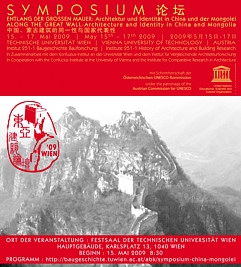
Entlang der Großen Mauer: Architektur und Identität in China und der Mongolei
Zeit: 15.05.2009
Ort: Festsaal der Technischen Universität Wien Hauptgebäude TU, Karlsplatz 13, A-1040 Wien
15.-17. Mai 2009
Die Thematik des Symposiums wird im Rahmen von mehr als 30 Experten-Kurzvorträgen behandelt. Die Vortragenden kommen aus China, der Mongolei, Europa, Amerika und Australien.
Die Teilnahme am Symposium ist an allen der drei Veranstaltungstage frei.
Das Programm des Symposiums ist der Symposiums-Website abrufbar und wird dort laufend aktualisiert:
http://baugeschichte.tuwien.ac.at/abk/symposium-china-mongolei/
—————————-
Nowadays, with China becoming an economically key player, the Middle Kingdom also claims a leading in role in modern architecture by providing an international playground for experimental buildings. Some of them were on display during the 2008 Olympics. The thrilling design of the Beijing National Stadium by the Swiss architecture firm Herzog & de Meuron (also known as the „Bird’s Nest“) even became the emblematic landmark for a “new China” and the Summer Olympic Games.
It goes without saying that architecture always conveyed a symbolic meaning besides providing basic shelter. The Great Wall of China for instance, became so familiar to the eye of the (Western) viewer that it came to serve as a symbol for the whole country itself. It became an icon for the political unity of the Middle Kingdom, despite the fact that it never was one coherent building complex but rather the combined result of individual parts built in different time periods. We would like to discuss the existence and nature of the traditional and modern symbolic architecture in China and Mongolia; moreover, to what extent an architectural monument, an urban design plan, a certain construction method or material in general can exemplify an entire geographic region, a time period or a political system.
The hand of the Middle Kingdom certainly shaped the political, cultural and architectural landscape of Asia in the past several thousand years. However, it eventually came into being through a mutual exchange between the indigenous Chinese culture and its neighbouring regions: For example, the influence of the nomadic and sedentary peoples from the North, such as Xiongnu and Xianbei confederations or medieval Mongolian tribes, as well as the artistic influences from the West such as Greco-Roman, Sassanian, and Indian vocabulary that existed in Central Asia at the time.
The fusion of the building traditions in East Asia is one of the last mysteries within the long tradition of architectural research in Austria. In the early 18th Century, the Austrian architect Johann Fischer von Erlach, leading master-builder of the Habsburg Empire in the Baroque Period, published the first discourse on world architecture. His copperplate print A Plan of Civil and Historical Architecture (1721) already included selected examples of Chinese architecture.
The 2009 Vienna Symposium aims to address the past, the present and the future of the field, by focusing on traditional architecture, preservation and reconstruction of historical buildings, as well as modern architecture and urban planning in China and the bordering region of Mongolia.

